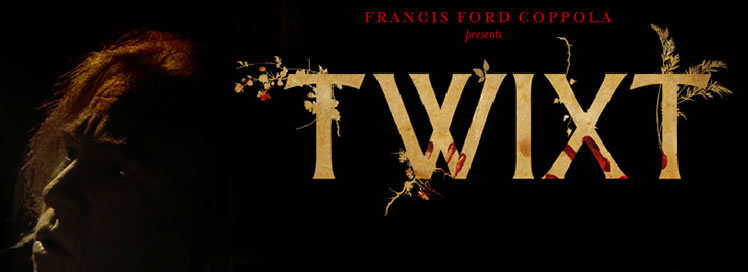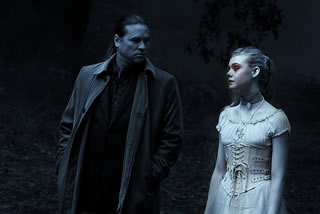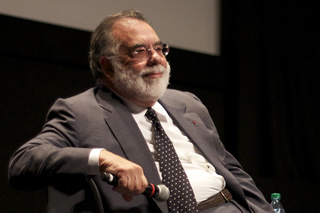Movies

New Releases • A-D • E-H • I-P • Q-Z • Articles • Festivals • Interviews • Dark Knight • Indiana Jones • John Wick • MCU

Twixt
Directed by Francis Ford Coppola
With Twixt, Francis Ford Coppola is in a playful mood and it all begins with an old-school American Zoetrope logo followed by an old-school American story.
Witch Hunter

Hall and V discuss grim events
Photo: American Zoetrope
The tone and timbre of Twixt is all in fun, but there's also a lot of heart beating through this spoof of - and tribute to - old school horror stories. The action takes place in a small town of vagrants, runaways, and retired folks; the sort of ménage who like to be left alone. It's a Twin Peaks-like environment in which the sheriff moonlights as a builder of bird houses – and bat houses.
Enter Hall Baltimore (Val Kilmer, Kiss Kiss Bang Bang). He's a "third-string horror writer" on a book signing tour. In this case, the bookstore is a wall of book shelves situated in a hardware store.
Poor Hall is derided as a "bargain basement Stephen King" by the sheriff, even as the sheriff hits up Hall for his autograph. That slight aside, Sheriff Bobby LaGrange (the legendary Bruce Dern, Silent Running) also sees Hall as his ticket to the big time. He wants to co-author a true crime story with Hall and his story is in the morgue waiting for them to exploit.
The case involves an obsessive, possessive preacher, the murder of 12 children, and a 13th who got away. That runaway is a ghostly girl named V (Elle Fanning, Super 8).
Poetic Moon
Coppola piles on the creepiness, some of it with his tongue firmly planted in his cheek. There are empty swings eerily swinging, bathed in the light of a poetic moon. And there's also a seven-faced clock tower, with each face telling a different time.
It's a story that runs by its own logic; the seven-faced clock is reason enough for people to get breakfast at the local greasy spoon at any time of day. (And be sure to catch Robert DeNiro's brief cameo as a two-bit barrista at that diner.)
With all of that derivative horror genre material serving as a backdrop, Coppola swoops in and works his own magic like only Coppola can do.
Perhaps the movie's single best scene shows Hall struggling mightily at the keyboard while working in a dodgy little hotel room. He's a schlock writer at his lowest point. Laughs come from his attempts to write in different voices, including that of Don Corleone. Then the scene deftly shifts from tickling the ribs to tugging at the heart strings with a punch of the "delete" key. That's the work of a masterful writer and director.
Indeed, more than a horror story, Twixt is a delicious little truffle about the art of writing and the sources of inspiration that fuel creative energy.
Got Bats?
The creative energy on display here toys with sources of literary inspiration and cinematic presentation.
Hall's surname, Baltimore, is a clue to a key historical figure who provides spiritual guidance to Hall in black-and-white scenes with accents of red. Blood red that's seen on stained clothes and pale skin.
And as an extra little surprise Coppola dabbles in 3-D, not so much to cash in on the 3-D craze, but more to poke fun at it. Amounting to only a few minutes of the film's 90-minute runtime (3-D glasses rise up on the screen to indicate it's time to don the glasses, then are pulled away when it's time to return to 2-D), the couple of climactic scenes are also the best use of 3-D in a very painfully long time. It's blood in your lap, objects in your face 3-D and it's a delightful blast.
The stellar lead actors have already been mentioned. Kilmer, Dern, and Fanning are all on Coppola's wavelength and deliver terrific performances. But it's also great to see Don Novello back on the big screen. He's worked with Coppola before (The Godfather Part III and Tucker: The Man and His Dream) but he's probably best known as Father Guido Sarducci on Saturday Night Live. The cleverest bit of casting, though, goes to the woman playing Val Kilmer's hard-nosed, cash-strapped wife (via Skype). That's Joanne Whalley (Scandal), who really was, once upon a time, Mrs. Kilmer.
Aside from the grim scenes that provide the grist for LaGrange's horror story, Twixt maintains a lighthearted tone right on through to the end. Revisiting a device used on American Graffiti (co-produced by Coppola), the fictional characters are given real-world gravitas via end title cards that provide follow-up details on post-film events. In this case, it's revealed Hall's wife didn't sell his coveted, hand-crafted edition of a Graham Greene novel. In contrast to Greene's enduring greatness, it's also revealed the LaGrange-inspired novel sold 30,000 copies. "Not bad business," opines the cheeky summation.
• Originally published at MovieHabit.com.



